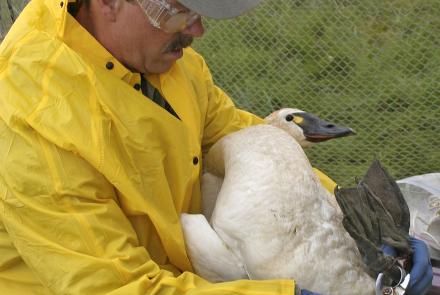Bowhead Whales May Be the World's Oldest Mammals
While helping Alaska Native whale hunter Billy Adams cut sections of blubber from a bowhead whale, Biologist Craig George pressed his knife into a deep scar in the whale's skin. The knife made a crunching noise, so George cut deeper. Minutes later, he pulled out a sharp harpoon point the whale had been carrying for perhaps a century.
Ten years earlier, whaling captain Fred Ahmaogak from Wainwright found an ivory harpoon tipped with a metal blade. As of early 2001, hunters have recovered six of these old harpoon points from bowhead whales. Along with new chemical evidence from the whales' eyes, the harpoon tips suggest that the bowhead may be the oldest living mammal on Earth.
George, who works for the North Slope Borough in Barrow, has studied bowheads for 21 years. The whales grow to 60 feet, weigh one ton at birth, and can weigh more than 120,000 pounds as adults. Insulated by blubber more than one foot thick and shielded by heavy bones in their skulls used to break holes in sea ice, bowheads spend their entire lives in northern waters.
Northern Inupiaq and Yupik hunters have killed bowheads for more than 1,000 years. The Alaska Eskimo Whaling Commission manages hunts in which crews from 10 villages take about 40 bowheads each year. George found the old harpoon point after a May 1992 hunt. Whaler Ben Ahmaogak Sr. from Wainwright found two stone points inside a large whale in 1993.
"Archeologists and anthropologists say that stone weapons were pretty much out of use by the turn of the century," George said from his office in Barrow.
Scientists previously thought that bowheads had a lifespan similar to other whales, but the old harpoon points hint that some of the whales alive today were swimming in the cold waters of the circumpolar oceans more than 100 years ago. To learn more, George contacted Jeffrey Bada of the Scripps Institution of Oceanography in La Jolla, California.
Bada is a geochemist who uses a method of determining the age of living things by studying changes in levels of aspartic acid, an amino acid found in the eye lens and teeth. He and marine biologist Mary Nerini aged bowheads in the mid 1980s, but some researchers questioned the legitimacy of their results until the independent evidence of the stone harpoon points surfaced.
George sent Bada 48 frozen bowhead eyeballs, each about the size of a billiard ball, he and other biologists had saved from whale hunts in Barrow, Gambell, Wainwright, Point Hope, and Savoonga from 1978 to 1997. George knew the relative ages of the sampled whales, but he didn't tell Bada, who nonetheless determined which sample came from an infant, a juvenile, or an adult.
Bada found that most of the adult whales were between 20 and 60 years old when they died, but five males were much older. One was 91, one was 135, one 159, one 172, and the oldest whale was 211 years old at the time of its death. That whale, alive during the term of President Clinton, was also gliding slowly and gracefully through the Bering, Chukchi and Beaufort seas when Thomas Jefferson was president.
Bada explained that the method of measuring changes in aspartic acid to determine age has an accuracy range of about 16 percent, which means the 211 year-old bowhead could have been from 177 to 245 years old.
The oldest known ages for mammals are 110 years for a blue whale and 114 years for a fin whale, based on a Japanese scientist's counting of waxy laminates on the inner ear plug of the whales, a method that does not work for bowheads. The oldest living person with a birth certificate was a 122-year-old woman from France who died in 1997. Elephants have lived to 70 in captivity, so bowheads may be the oldest mammals that exist.
Why do bowhead whales live so long? George speculated that the bowhead's tough environment-cold water without abundant food available-forces it to maintain a great body mass, an effective system for fat storage and an efficient mechanism to keep warm. The stress of living in arctic waters may nurture the whale's pattern of slow growth and long life.
"They just take longer to do what mammals do farther south," said Craig, who added that he has taken a bowhead's approach to higher education as he pursues a Ph.D. through the University of Alaska Fairbanks. "Like me-I'm closing in on 50 and I'm still in graduate school."




